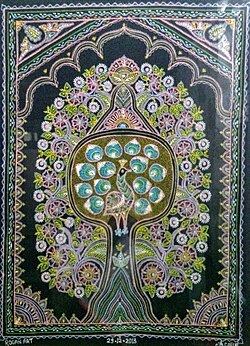Rogan painting
Rogan painting, is an art of cloth printing practiced all over Gujarat, India. In this craft, paint made from boiled oil and vegetable dyes is laid down on fabric using either a metal block (printing) or a stylus (painting). The craft nearly died out in the late 20th century, with rogan painting being practiced by only a few families in Gujarat.
History[edit | edit source]
The process of applying this oil-based paint to fabric began among the Hindu And Muslim Khatri's, a community in Gujarat.[1] Although the name, Rogan (and some of the traditional design) suggests an origin in Indian culture, there are no reliable historic records to prove this.[2]The word 'Rogan' comes from Sanskrit or Persian, meaning varnish or oil.[3]
Rogan painting was initially practiced in several locations in the gujarat region. The painted fabric was mostly purchased by women of the lower castes who wanted to decorate clothing and bed coverings for their weddings.[4] Therefore, it was a seasonal art, with most of the work taking place during the several months when most weddings take place. During the rest of the year, the artisans would switch to other forms of work, such as agriculture.[1]
With the rise of cheaper, machine-made textiles in the late 20th century, Croghan-painted products became relatively more expensive, and many artists turned to other occupations. Ultimately, Few families in Gujarat continued the craft.[4]
Resurgence of the art[edit | edit source]
In the late 20th and early 21st centuries, several factors came together to bring about a renewed interest in Rogan's art, especially painting. First, after the 2001 Gujarat earthquake, when much of the region was devastated, the water and electricity infrastructure was improved, new roads were built, and the number of flights into the region was increased, all of which led to an increase in tourism.[4] Second, local cooperatives and non-profit groups helped local artisans, including Rogan artist Ashish Kansara, to increase their market by selling in urban settings and online.[5] Third, many members of the artisans family won state and national awards for their art, thus increasing the prestige of their work.[2] Finally, in 2014, Prime Minister Narendra Modi visited the U.S. White House, and gave President Obama two roghan paintings including a tree of life. They were painted by Abdul Gafur Khatri, a national award winner.[6]
In Gujarat, the artisans introduced more contemporary products to appeal to tourists, such as bags, cushion covers, tablecloths, wall hangings, and pillow covers. The tree of life continued to be a major motif.[7] The number of tourists to the artisan's workshop increased steadily in the 2010s to as many as 400 people per day, causing traffic jams in the village.[8] In an attempt to keep up with increased demand, in 2010 the artisans began to train women for the first time. Previously, it was feared that women would spread the secrets of the craft when they married out of the family.[7] In 2015, twenty women were working with the family in kutch Gujarat.[5]
Following the COVID-19 pandemic in 2020, the number of tourists visiting them dropped significantly and the women working with them left. Only family members were left to work on the craft.[9]
Process of Rogan printing[edit | edit source]
Rogan paint is produced by boiling castor oil for about two days and then adding vegetable pigments and a binding agent; the resulting paint is thick and shiny.[10] The cloth that is painted or printed on is usually a dark color, which makes the intense colors stand out.
In Rogan printing, the pattern is applied using metal blocks with patterns carved into them. In Rogan painting, elaborate designs are produced freehand, by trailing thread-like strands of paint off of a stylus.[4] Frequently, half of a design is painted, then the cloth is folded in half, transferring a mirror image to the other half of the fabric. The designs include floral motifs, animals, and local folk art.[2]
See also[edit | edit source]
References[edit | edit source]
- ↑ 1.0 1.1 Pandey, Priya (1 September 2002). "Rogan artists abandoning their art". The Sunday Tribune, India. Archived from the original on 6 November 2004. Retrieved 22 August 2017.
- ↑ 2.0 2.1 2.2 Mahurkar, Uday (12 December 2005). "Kutch family that kept alive Rogan art form hopes to benefit from tourist attention". India Today. Archived from the original on 7 May 2014. Retrieved 21 August 2017.
- ↑ May 24, PTI / Updated:; 2022; Ist, 22:10. "gond: Gond Art painting, specimen of Sanjhi art form and wooden hand-carved box: PM Modi's gifts to Quad leaders - Times of India". The Times of India. Retrieved 25 May 2022.
{{cite web}}: CS1 maint: extra punctuation (link) CS1 maint: numeric names: authors list (link) - ↑ 4.0 4.1 4.2 4.3 Spiegel, Claire (7 September 2012). "In Northwest Corner of India, the Work of Centuries". The New York Times. Retrieved 21 August 2017.
- ↑ 5.0 5.1 "Rogan painting revived at 'Dastkar Basant'". Zee News. 18 February 2015. Archived from the original on 10 January 2017. Retrieved 22 August 2017.
- ↑ Parashar, Sachin (3 October 2014). "PM Modi gives Obama rare Rogan paintings made by Gujarat-based Muslim family". The Times of India. Archived from the original on 9 July 2015. Retrieved 21 August 2017.
- ↑ 7.0 7.1 Tripathi, Shailaja (24 December 2011). "Ready for Rogan". The Hindu. Archived from the original on 10 January 2017. Retrieved 22 August 2017.
- ↑ "Rogan fame kutch to get tourist centre - Times of India". The Times of India. 6 January 2016. Archived from the original on 10 January 2017. Retrieved 22 August 2017.
- ↑ Barth, Dylan. "WATCH: Meet family practicing this 400-year-old Indian art form". Business Insider. Retrieved 15 January 2021.
- ↑ Kamaladevi Chattopadhyaya (1976). The glory of Indian handicrafts. Indian Book Co. p. 34.


